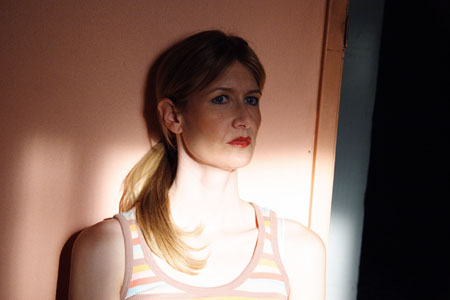|
Reviews of Recent Independent, Foreign, & Documentary Films in Theaters and DVD/Home Video
Written, Directed & Edited by: David Lynch. Produced by: Mary Sweeney & Lynch. Cinematography by: Odd-Geir Saether. Music by: Angelo Badalamenti. Released by: Studio Canal. Country of Origin: USA/France/Poland. 179 min. Rated R. With: Laura Dern, Justin Theroux, Jeremy Irons, Harry Dead Stanton, Grace Zabriskie, Julia Ormond, Diane Ladd, William H. Macy, Mary Steenburgen, Natassia Kinski, Naomi Watts, & Laura Harring. I knew, as with practically every other David Lynch film I’ve seen so far, to expect the unexpected. By the end of this picture's 189 minutes, I knew I had seen a work that if Lynch died tomorrow (not that I would want him to, of course) would be a near-great swan song. In some ways, it’s a look into what this director has on his mind, for greater or lesser for the audience, and a wonderment by a filmmaker working independently of the system (over three years) to make the work on his terms. It also teeters on being too big, too mind-f***ing, and is at least 10 minutes too long, but Lynch uses his cast and (limited) crew to create a complex web of abstractions, moods, emotions, and rabbits on couches. First off, to attempt to tell what the story is about...actually, never mind. It would be almost futile to try and describe it all, because, frankly, even on a repeat viewing I don’t think I would get everything. All I’ll say is that Laura Dern plays an actress, Nikki, who lands a part in a film by the director Kingsley (Jeremy Irons), and costarring Devon (Justin Theroux). While in rehearsal, the actors learn that the film they’re making is technically a remake of one never finished; the actors on that film were murdered under mysterious circumstances. Like Lynch’s Mulholland Drive, there seems to be at least SOME logic to the story for a brief period. Then, slowly but surely, we’re taken away from the “typical” and put into what Lynch has described as “dream logic.” Soon, there seems to be some sort of alternate reality, or alternate realities, and for the bulk of the film we’re treated to images, scenes, moments, passages of dialog that all flow almost like music or poetry. I know that last part might sound pretentious, but it’s the only way I can really relay what Lynch has in store. In terms of the acting, it’s dynamic, creative, and absorbing. Even if it is largely Lynch’s movie, it’s also Laura Dern’s tour de force as she goes deeper into other characters (i.e. Sue, the role she plays in the film project) in perhaps her greatest work to date. Through Lynch’s scenes of surrealism, the absurd, and almost otherworldly, she ends up going through all the emotions one could think of – sadness, bewilderment, shock, awe, disgrace, delirium, anger, frustration, pain, and it all adds up to being why many of us go to the movies. Meanwhile, others like Grace Zabriskie, Irons, and Harry Dean Stanton get their moments too. On the technical side, it’s the first time Lynch has shot a feature film digitally. But not only does he and cinematographer Odd-Geir Saether pull it off, it’s often really extraordinary. There’s a true sense of visual freedom with a digital camera, even if here and there a shot might be fuzzy or the lights might make scenes seem too bright or too dark. And this visual freedom provides Lynch opportunities not really tapped like this since Eraserhead, providing many a memorable moment. One that sticks in my head: Dern and Theroux are in bed (I won’t say why or how), and there’s a blue tint to the room, and the close-up compositions make it extremely striking. Close-ups, too, are crucial in the film, and there’s the risk of overkill. But with so many different kinds of shots, the filmmaking possibilities seem endless. And yes, the rabbits are quite freaky, indeed, when shown. It’s often, through many a dramatic or downright crazy scene or sequence, a funny movie, perhaps unintentionally. There’s a certain absurdism that comes into play, and the perverse, strange and “what was that” kind of moments all abound. For example, Nikki/Sue, in one of these alternate types of realities, comes into contact with a group of women who sometimes talk about their looks or nothing much, and then break into dance numbers for “The Loco-Motion” and “At Last.” One ends up laughing, even if there is no sense to it. The lack of logic is a challenge. But if you give yourself to the material, the themes and ideas come through, and they’re very fulfilling in connection with the abstractions. The film’s got ideas about cinema itself at its core, about how we watch movies and watch people act in them, and how un-realities cross with realities and end up back in a reality where feeling and understanding is more important than knowing everything.
If I haven’t made things totally clear, don’t fret. If there is a liability in all of this, it’s that, unlike Drive, Lynch isn’t totally able to sustain all of his wild ideas and images and mixing together of fantasies and realities and so forth in three hours. That there’s so much though that sticks in the mind once it’s done, and so much that can stir up questions and things to talk about is a credit to Lynch. And if you need any more assistance, call the rabbits up.
Jack Gattanella
|

